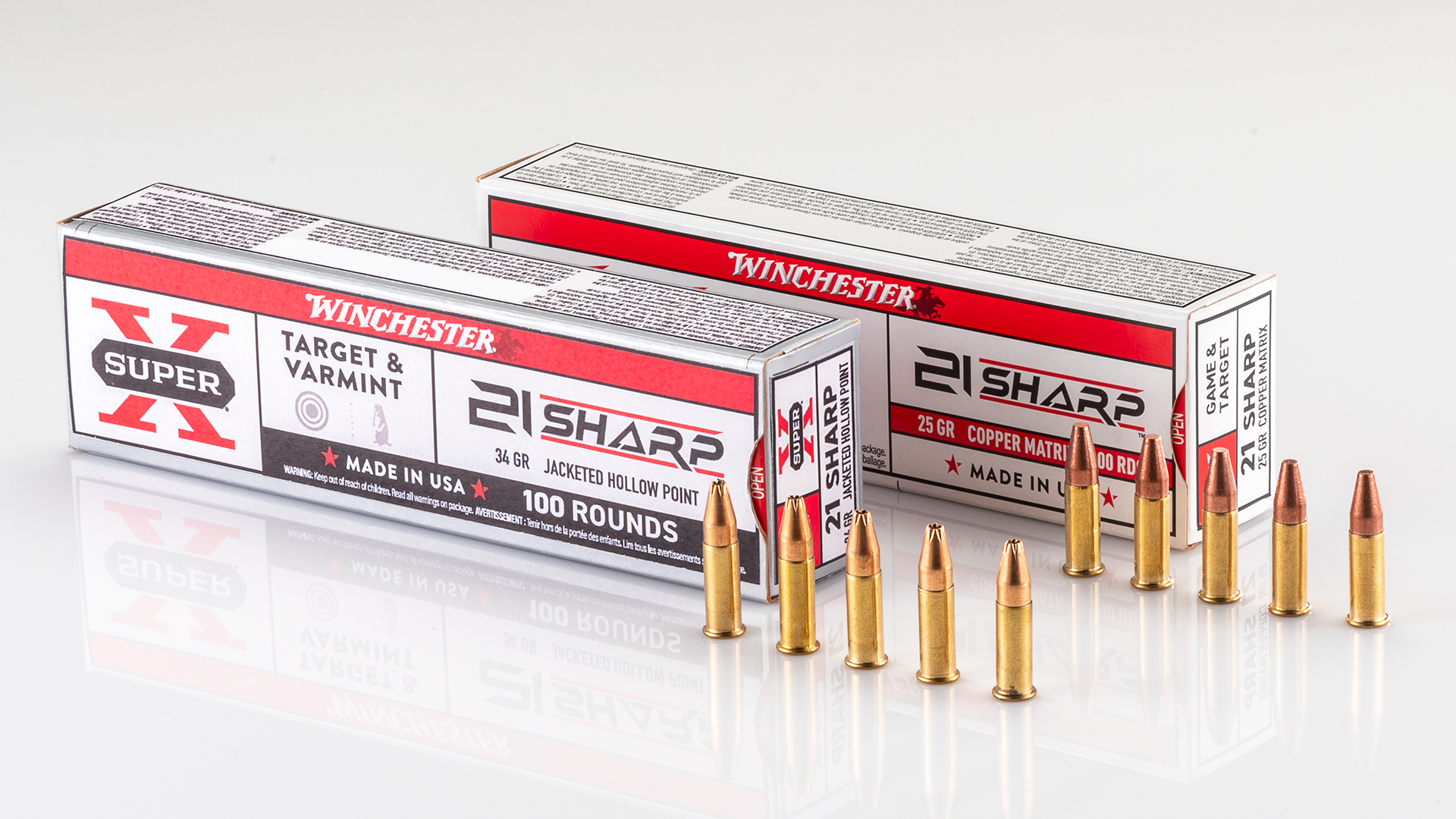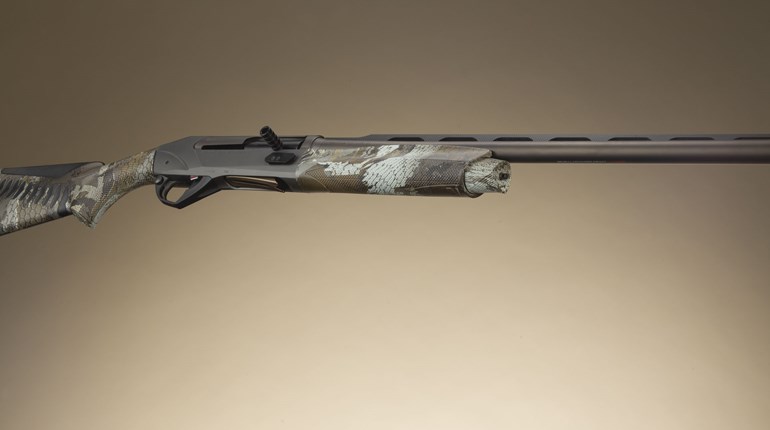
I’m betting plenty of American Hunter readers never considered that the .22 LR could be improved, much less that it needs to be. But that’s not how the gun geeks at Winchester Olin look at such things.
Evidently they ask, “Can we do it better?” and “Should we do it better?” and “Will the shooting public buy it?” … in that order. Over time, this line of questioning by professional ballisticians and marketers is how American hunters and shooters—indeed the world at large—is offered new and improved calibers from which to choose each year. Whether those calibers stick around is up to us as consumers, and that is how it should be in a capitalist economy.

One such new caliber that’s sure to get the “Do we really need that?” people clamoring, but one that offers real advantages over the venerable .22 LR, is Winchester’s new 21 Sharp. As simply as I can put it, it’s a rimfire cartridge that utilizes a .22 LR case but a .21-caliber, non-heeled projectile that offers several key advantages over the standard .22-caliber projectile yet remains affordable. My job here is to explain, so please allow me to convey Winchester’s reasoning for introducing this new cartridge. If you’ll read to the end, I assure you there is a pragmatic reason for the 21 Sharp’s conception.
The .22 LR was conceived in 1887 as an evolution of the less powerful .22 Long, which was an evolution of the .22 Short, which was itself an evolution of the .22 BB Cap. The “hot new” 1200 fps .22 LR loading consisted of a 40-grain round-nosed, lead bullet that was “heeled,” meaning that the exposed portion of the bullet is the same diameter as the case. The rear of the bullet then, in order to fit into the case, had to be narrower than the exposed portion of the bullet. The base of this stepped design is called the bullet’s heel. It worked, but as you can imagine, it didn’t do anything for aerodynamics or terminal ballistics.
Regardless, every major ammo producer tooled up their factories for this leaden, heeled cartridge design and over time they were able to produce it extremely cheaply. However, one of the stepped bullet’s biggest problems deals not in ballistics but in mass manufacturing: It’s difficult to produce a premium (or even modern) jacketed bullet utilizing a heeled design. And it’s almost impossible to produce one at a cost similar to traditional lead .22 LR rounds. Frankly, the heeled design should have been remedied 100 years ago, because that’s how long ballisticians have known the design was inferior—and easy to fix. But it was not, and so here we are.
For the mechanically curious among us, the .22 LR’s bullet diameter is .2255 inch, compared to the 21 Sharp’s bullet diameter of .2105. Both cartridges are spec’d to the same maximum average pressure of 24,000 psi. Both have identical overall lengths of 1.00 inch, as well as identical case diameters, so both cartridges utilize the exact same case. While initial thoughts among industry folks were that surely the 21 Sharp would feature better ballistic performance due to the more aerodynamic projectile—and it does—the reality is that at the ranges for which this cartridge is intended (ideally inside 50 yards, max 150), the BC’s effect is negligible. Although Winchester Ammo says it will offer a range of bullet weights from 25 to 42 grains, the 21 Sharp’s primary loading at the time of this writing is a 34-grain JHP bullet, which, with an advertised muzzle velocity of 1500 fps, performs pretty close to a .22 Stinger. And we’ve had CCI’s Stinger round for 50 years. So … why did Winchester decide to make the 21 Sharp now? There’s one main reason, in my opinion, and I believe it to be very valid.
 The .22 LR’s heeled lead bullet, center, is flanked by Winchester’s nontoxic 21 Sharp 25-grain Copper Matrix, left, and 34-grain Jacketed Hollow Point, right.
The .22 LR’s heeled lead bullet, center, is flanked by Winchester’s nontoxic 21 Sharp 25-grain Copper Matrix, left, and 34-grain Jacketed Hollow Point, right.
Namely, Winchester can see the writing on the wall: Currently .22 LR sales account for 2.5 billion of the country’s total 10-12 billion rounds sold annually. Why does .22 LR continue to sell so briskly? Because it’s fun, useful, and because it’s cheap. Yet some states like California, as well as other countries, have banned lead ammo for hunting. Others have banned it outright. More jurisdictions are almost certainly on the way. And as I foreshadowed earlier, at this time it’s impossible to make a non-toxic .22 LR bullet en masse at the same cost as a lead one. So Winchester is hedging for the future while getting ahead of what competition is surely to come. Not only is it not wrong to do so, it’s smart. For all of us.
Recently I was invited on a prairie dog hunt in western Nebraska to test the new round. While I’d love to say it blew my socks off and was like a death ray on pesky dogs and this and that, I will refrain, because nothing about shooting a 1500 fps, 34-grain rimfire round can be all that dramatic. There was no red mist, triple flippers or 500-yard kills. Rather, I experienced accurate shooting with almost no recoil that lasted all day because the round is so affordable. Mainly though, it’s just fun to shoot, something I’m constantly reminded of each and every time I choose a rimfire. I will offer that I could feel the added velocity compared to a standard .22 LR … it had more snap at longer range when it struck a target. I could also tell that it bucked the wind slightly better than a typical .22 LR, and it did not require as much holdover when shooting at 100-plus yards. I experienced excellent reliability in the Xpert rifles that Winchester will initially chamber for the new load.
The .22 LR will always have a use in shooting, hunting and competition if the NRA has its way, because outpricing hunters and shooters is almost as bad as banning. But for folks in places like commie California who don’t wish to break the law, they now have an economical .22 LR-style option. They can rebarrel their guns for the 21 Sharp or, preferably, buy one of several new firearm models from Winchester, Savage and soon-to-be other companies who will offer factory guns in Winchester’s new California-friendly .22 clone, the 21 Sharp.

Technical Specifications
• Caliber: .21
• Action Length: rimfire
• Bullet Weights and Types Available in Factory Loads: 34-gr. Jacketed Hollow Point (tested); 25-gr. Copper Matrix (tested); 37-gr. Black Copper Plated Lead; 42-gr. FMJ
• Ballistic Coefficient: .087 (Copper Matrix); .116 (JHP)
• Muzzle Velocity: 1750 fps (Copper Matrix); 1500 fps (JHP)
• Muzzle Energy: 170 ft.-lbs. (Copper Matrix); 170 ft.-lbs. (JHP)
• Uses: plinking, small game
• MSRP per box: $15-$25/100-rnd. box; winchester.com




































